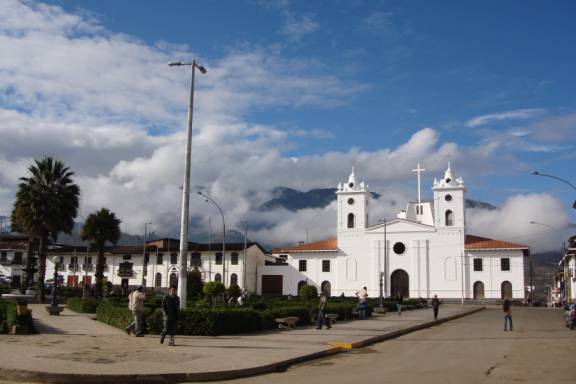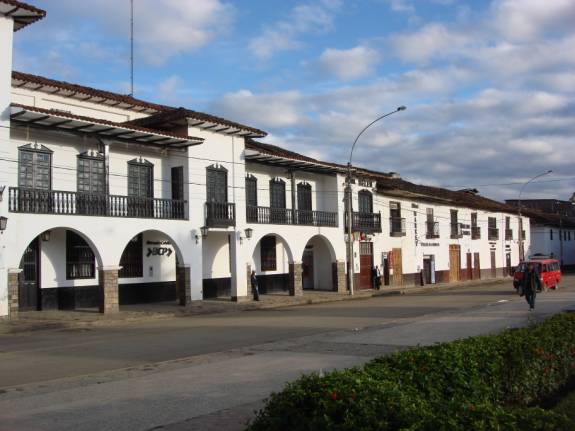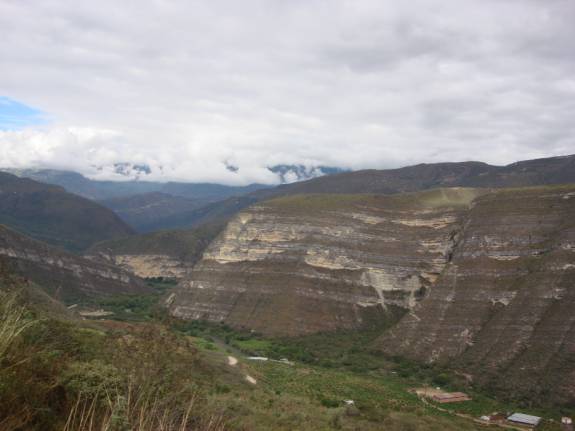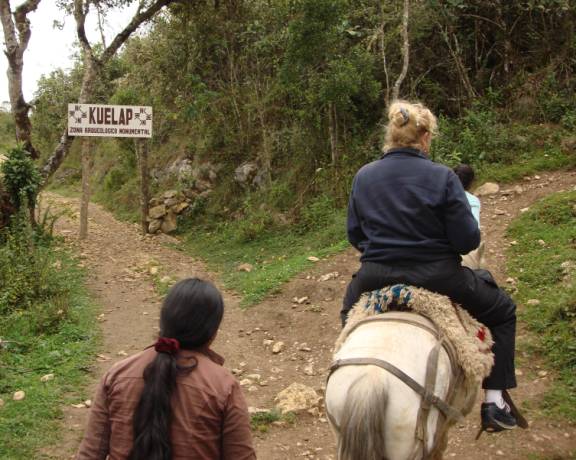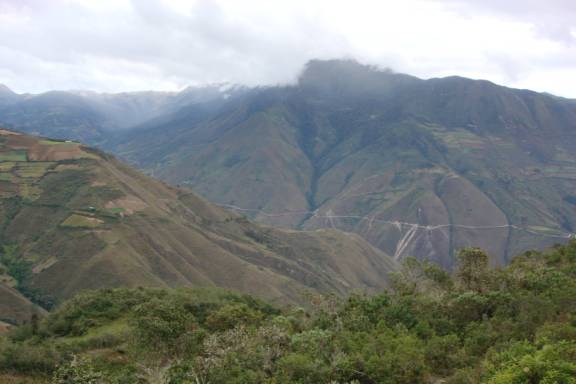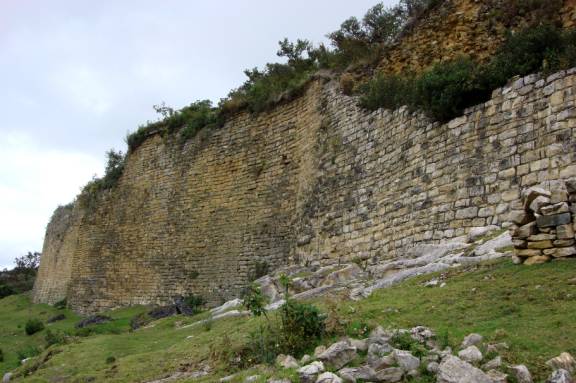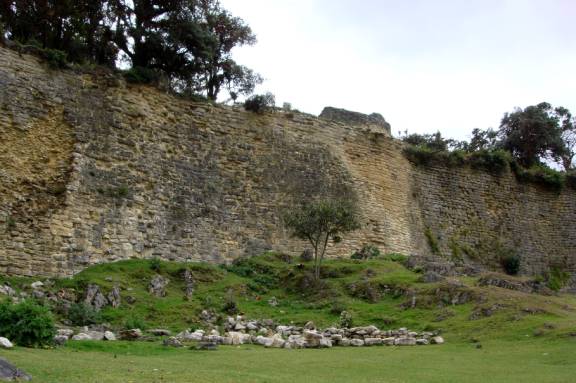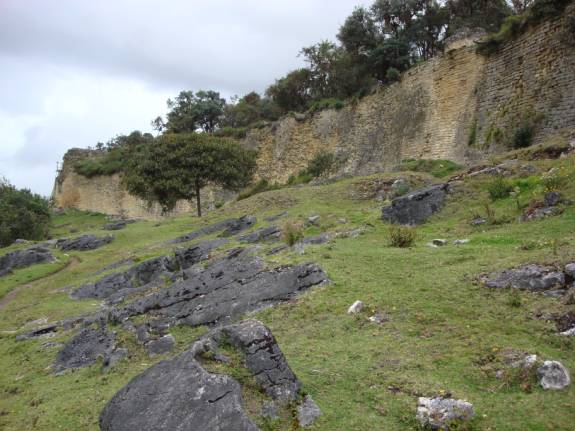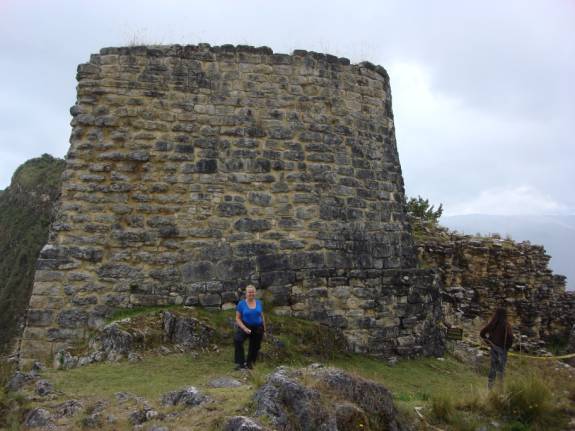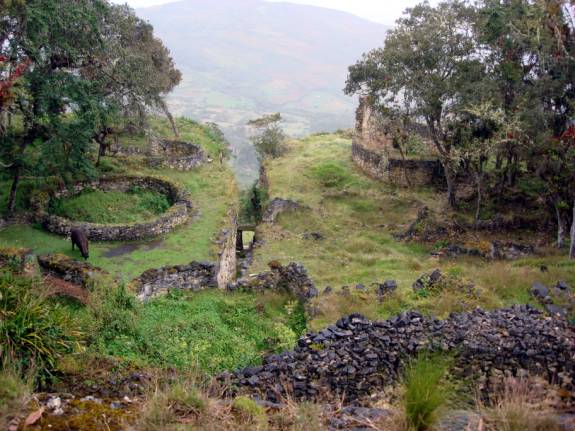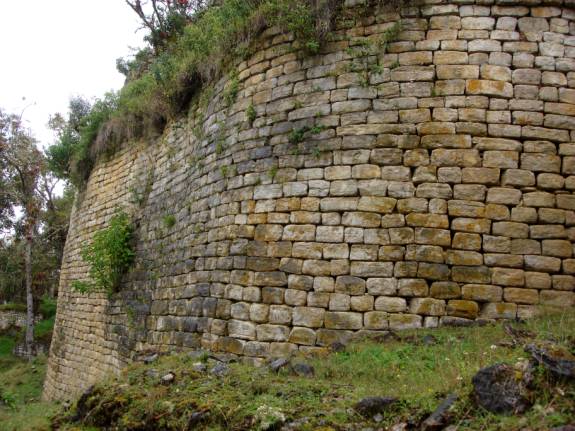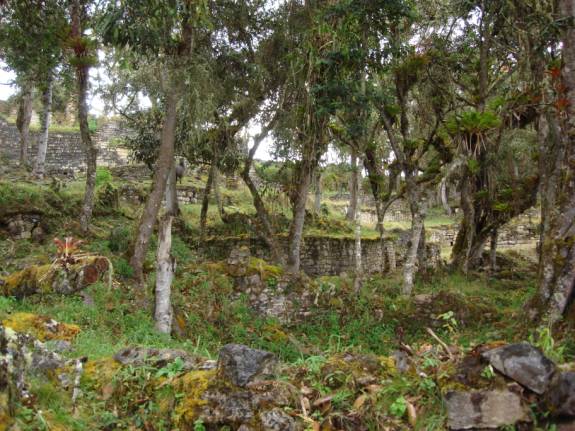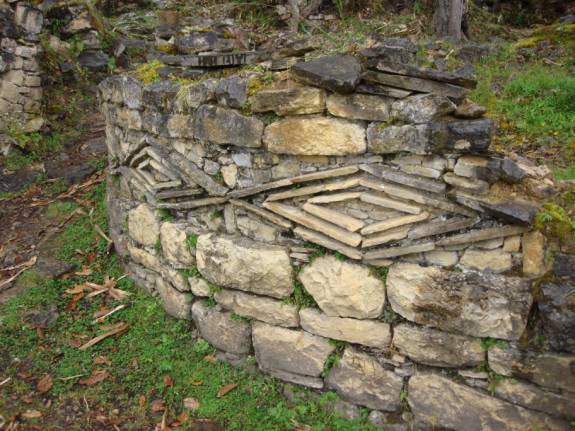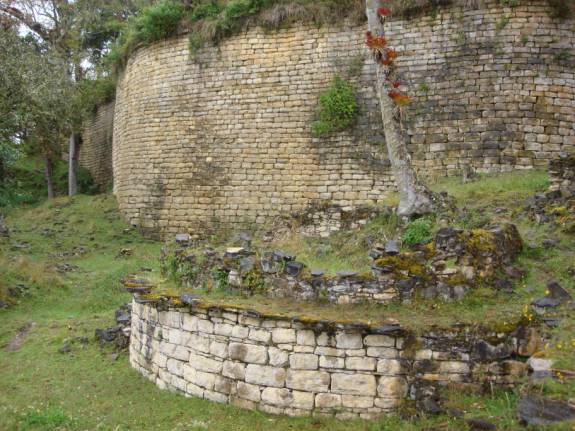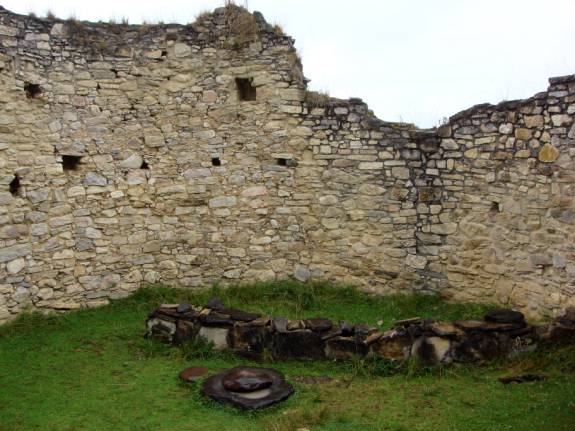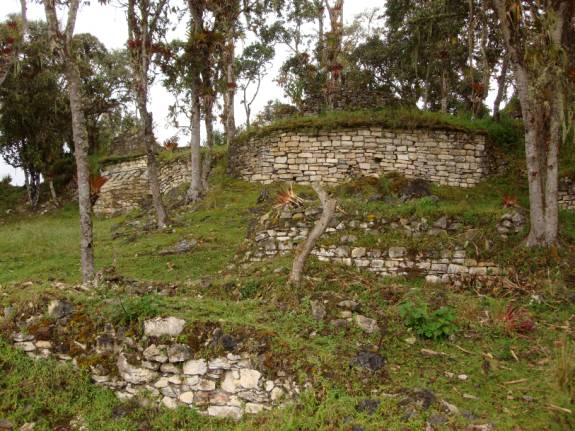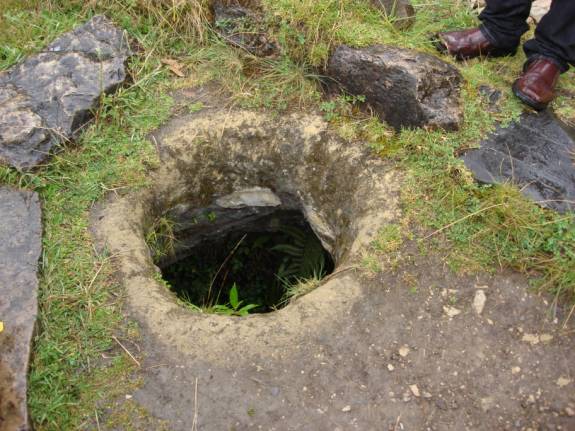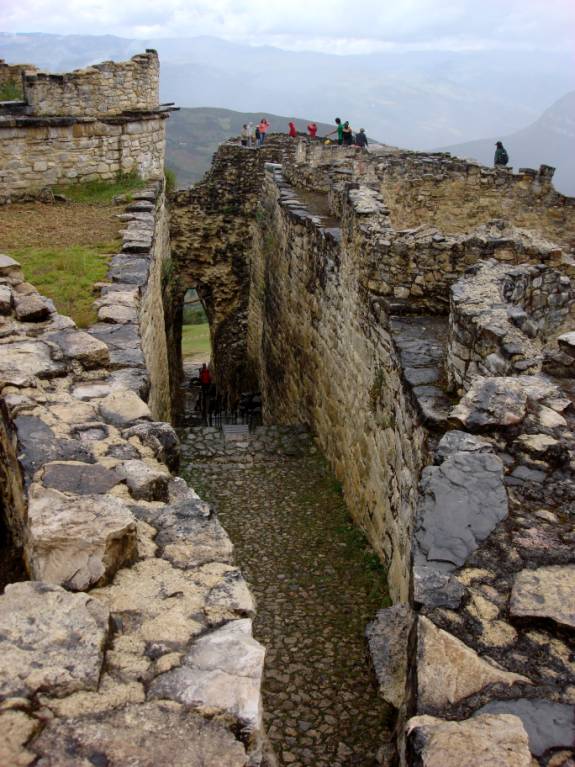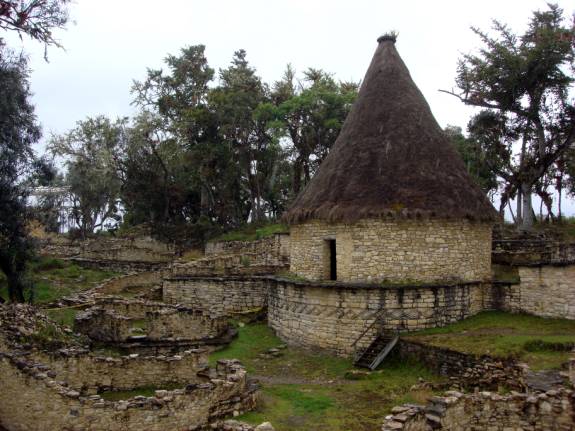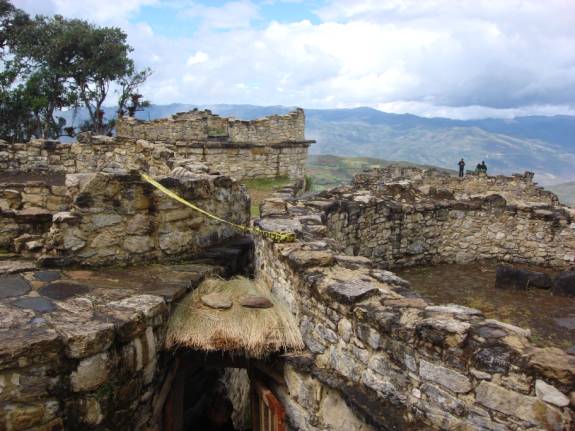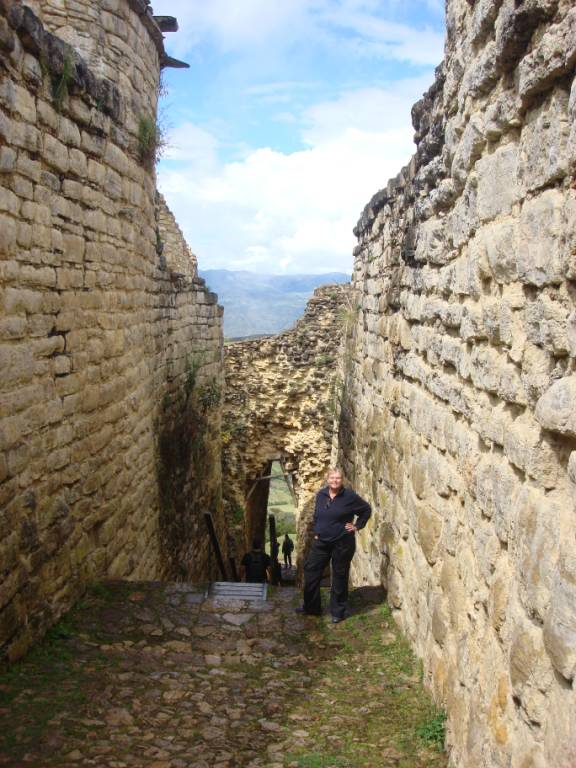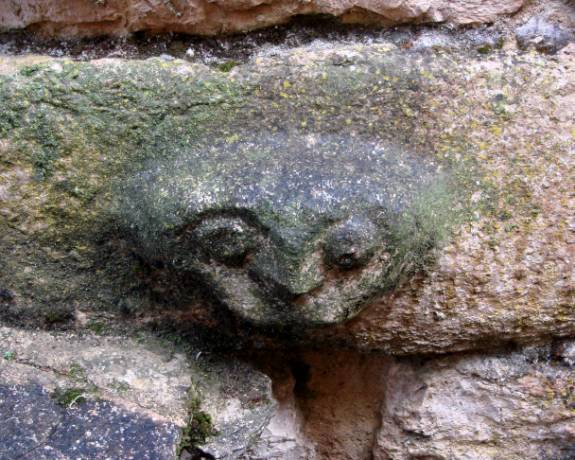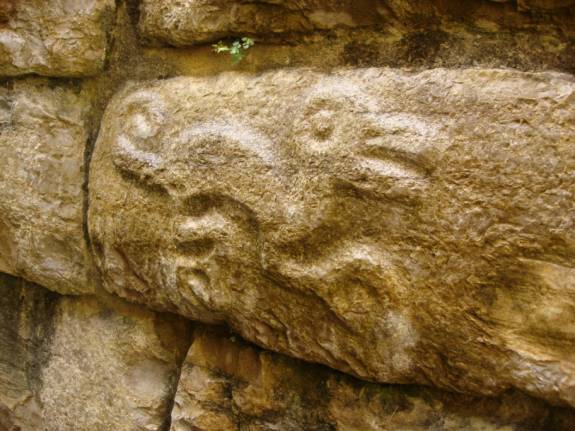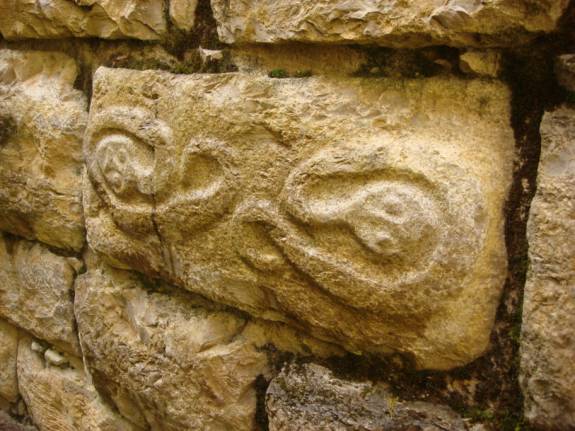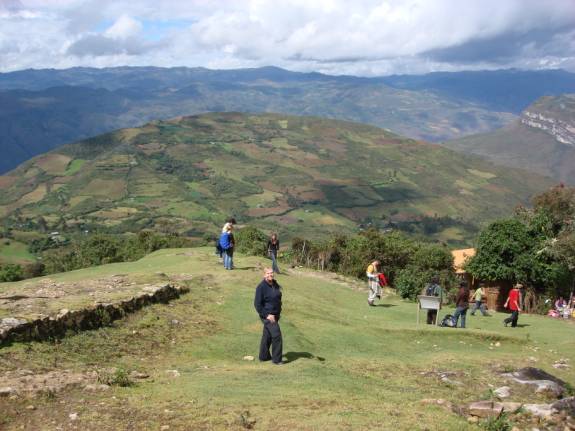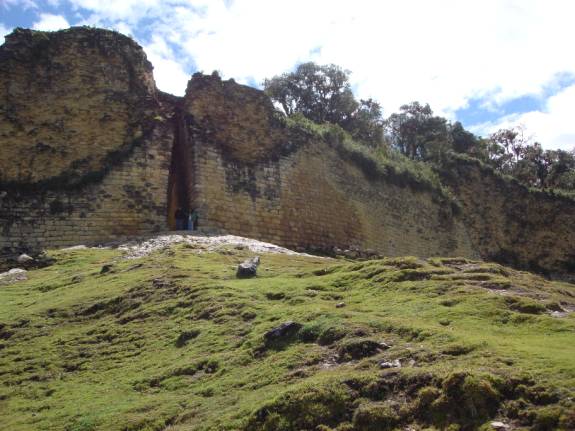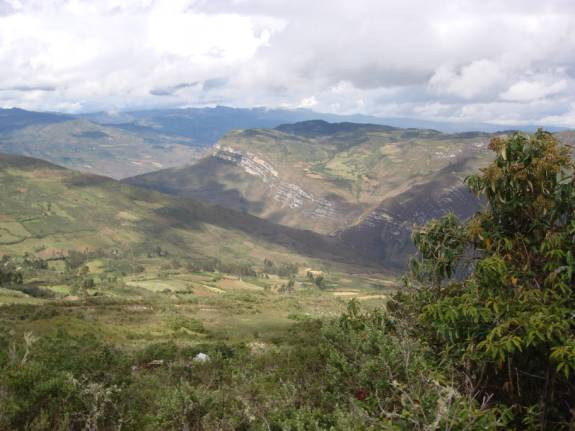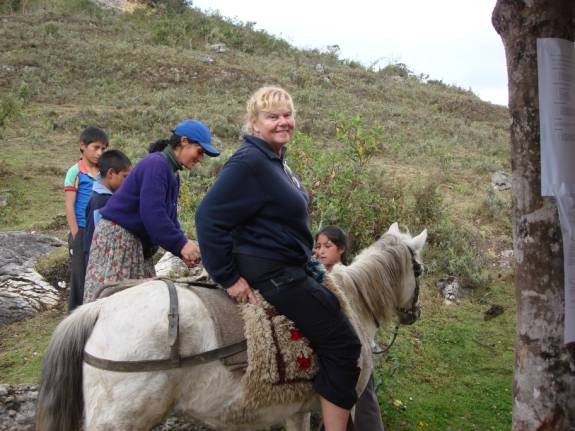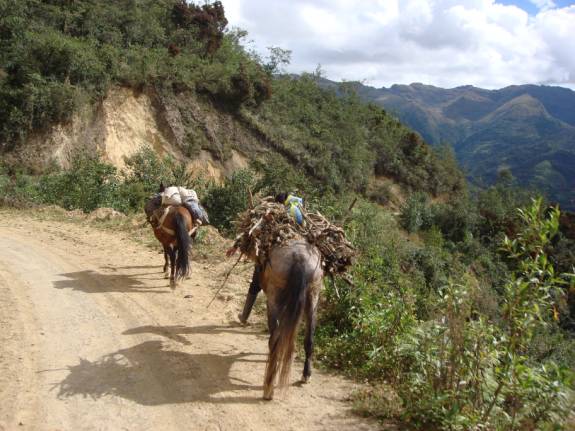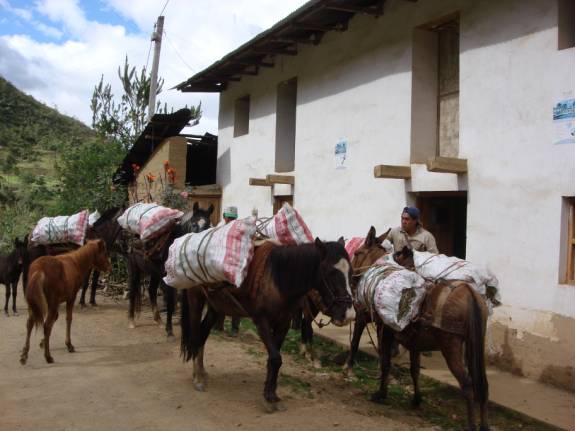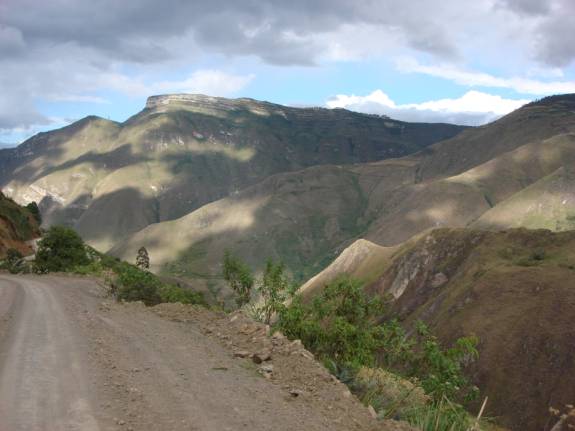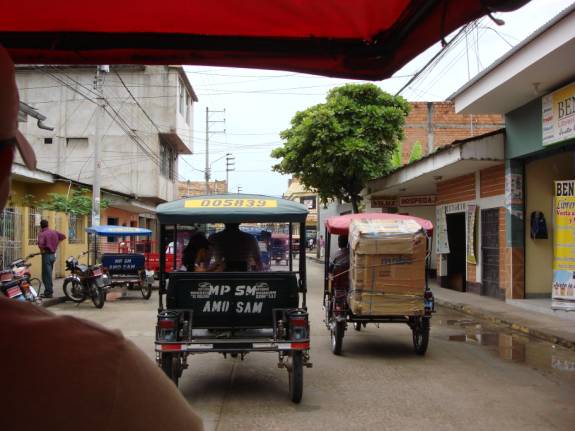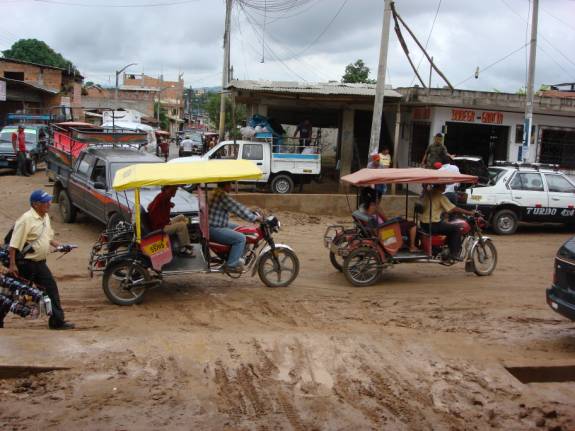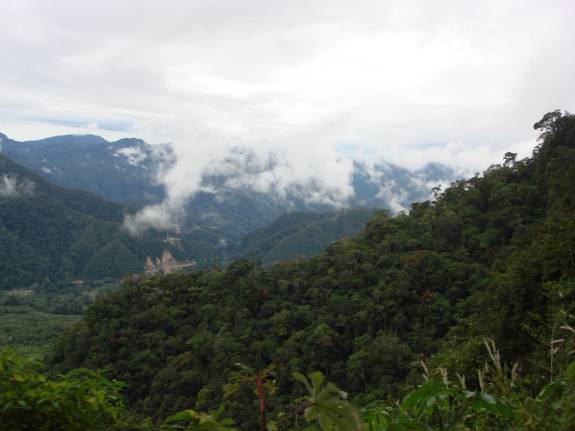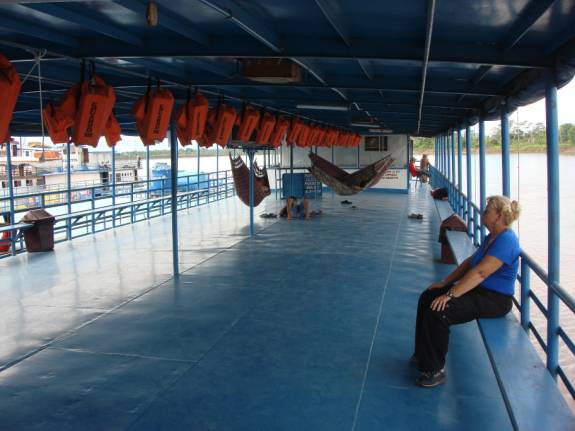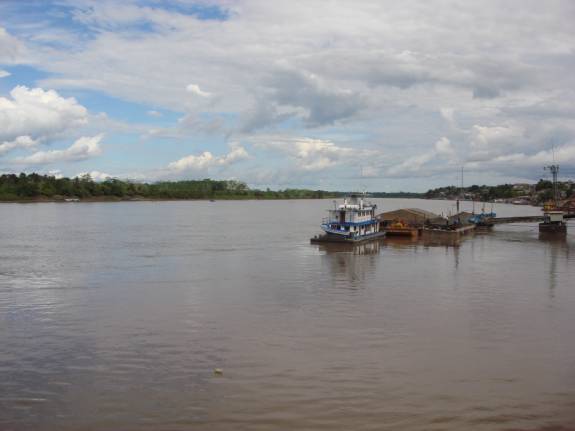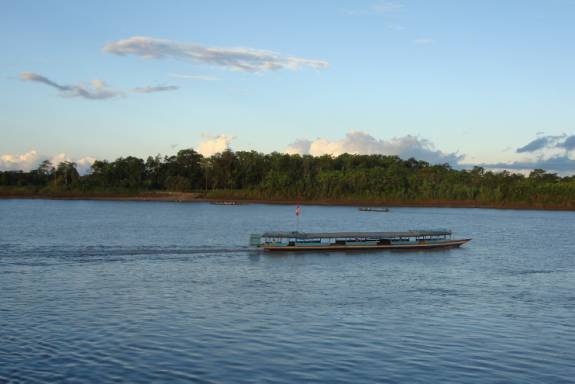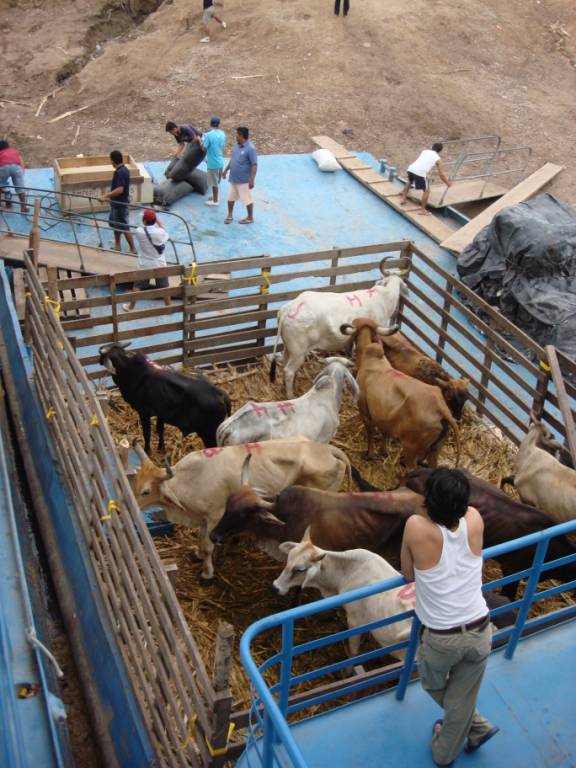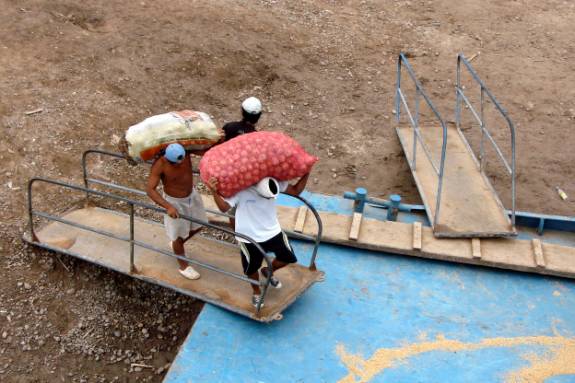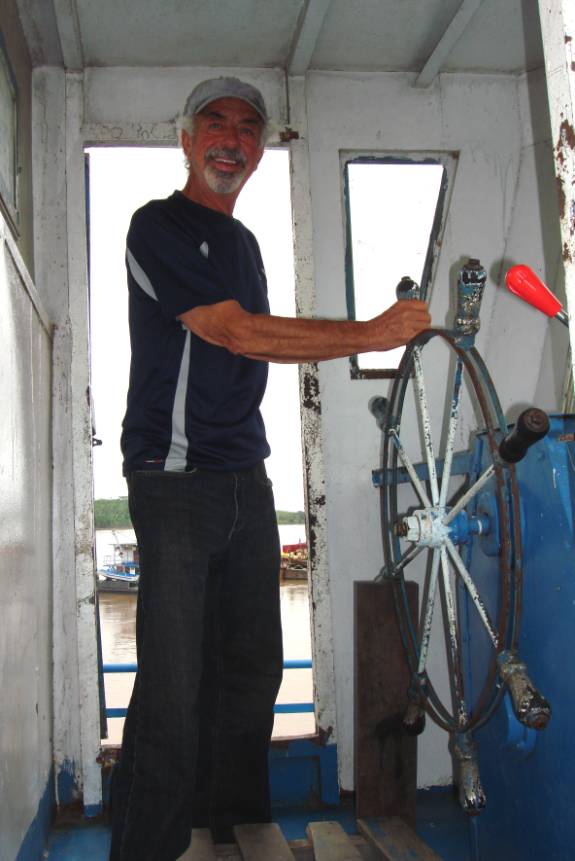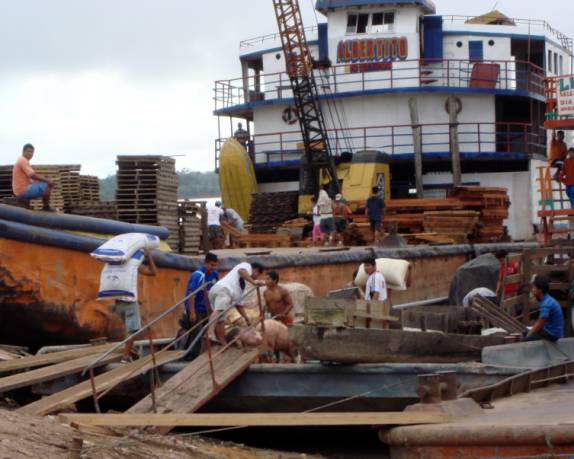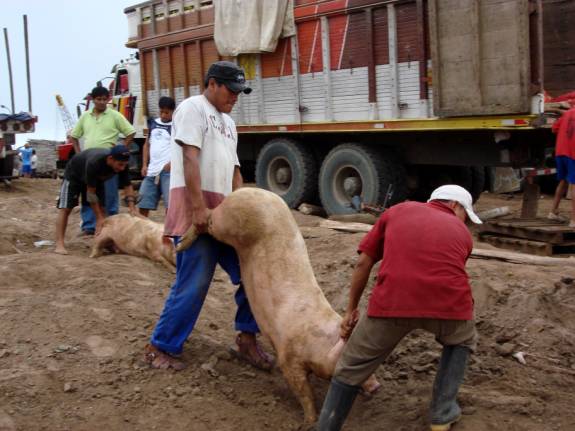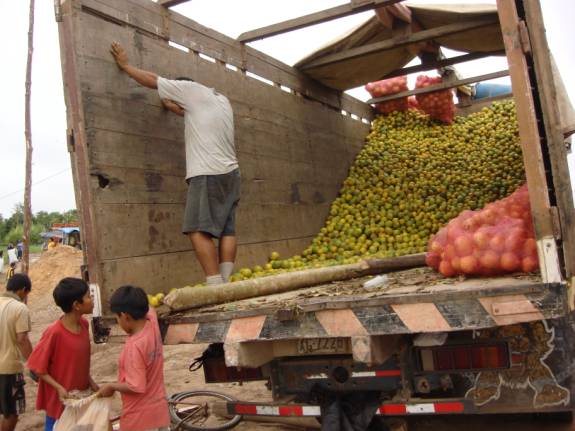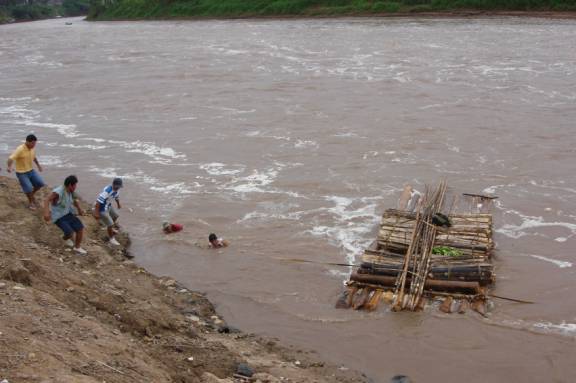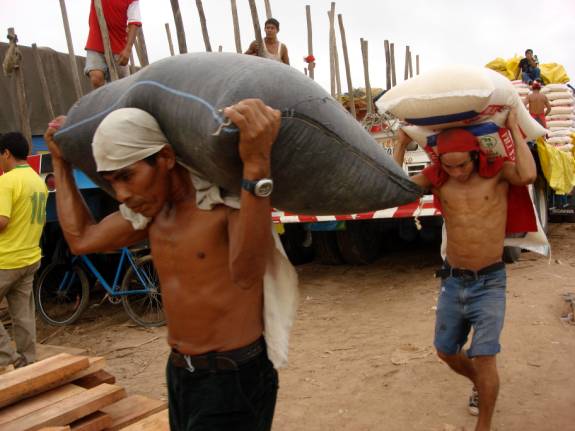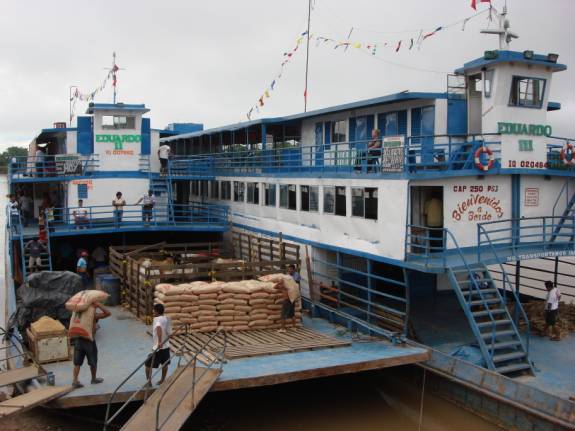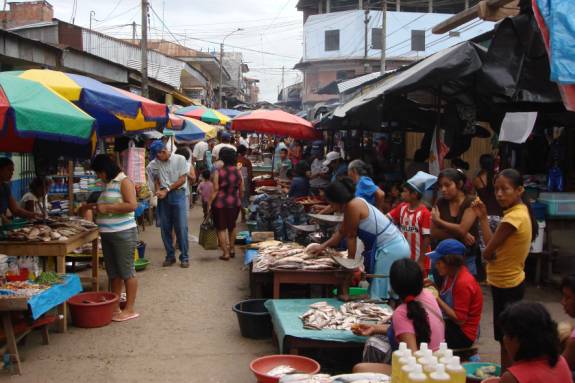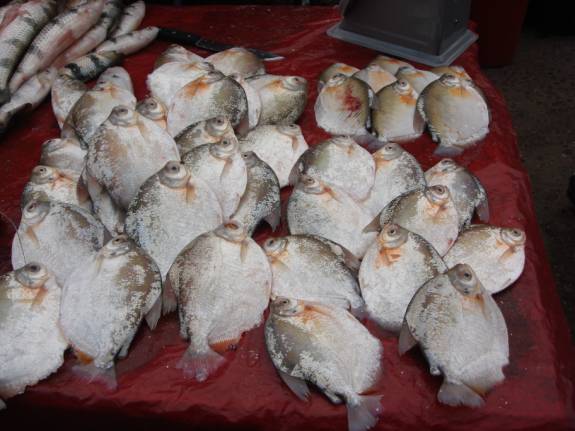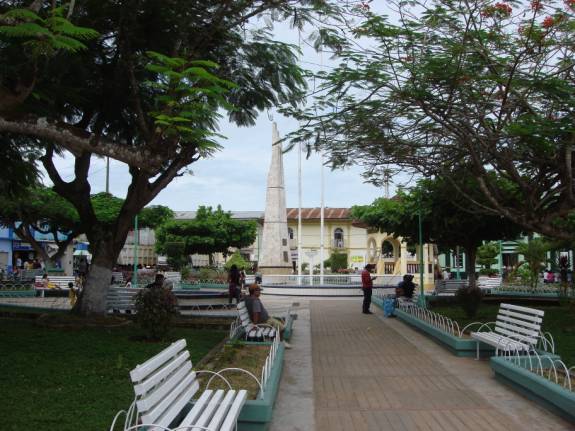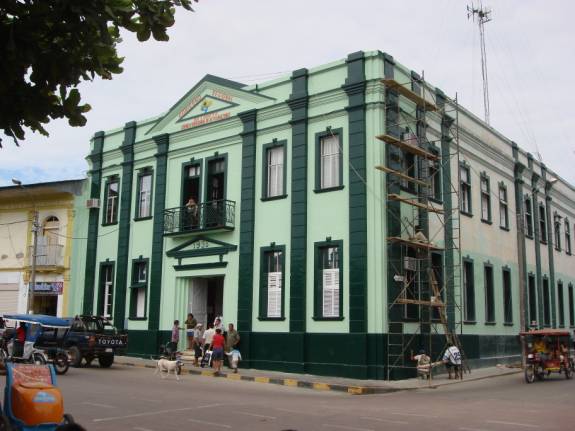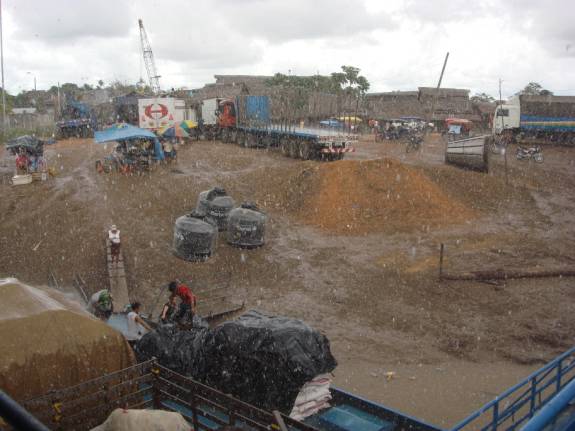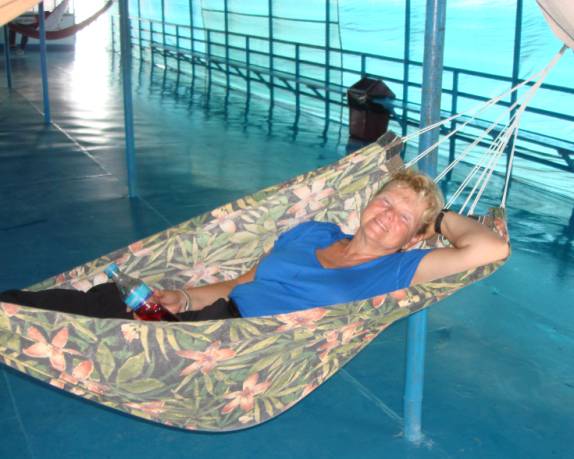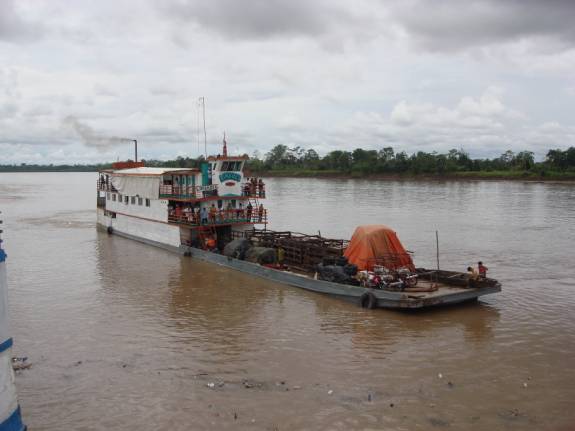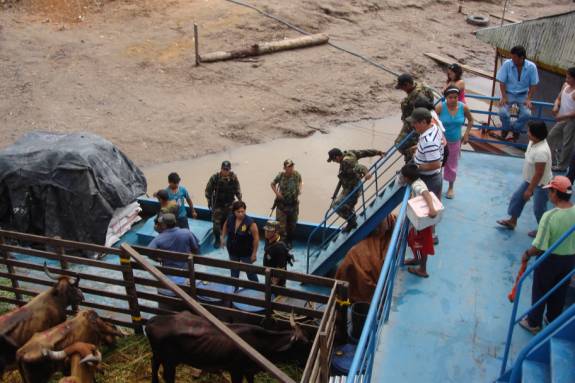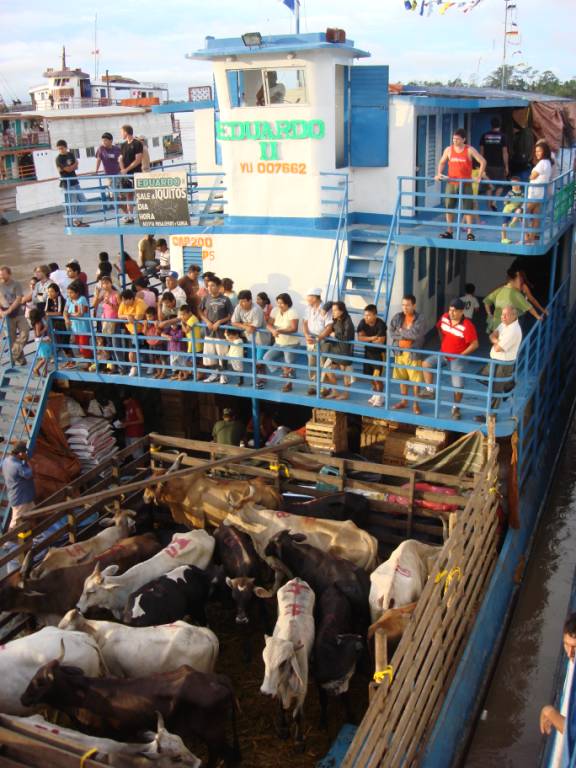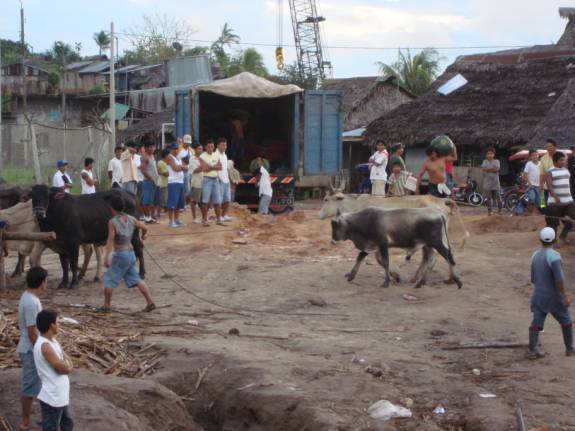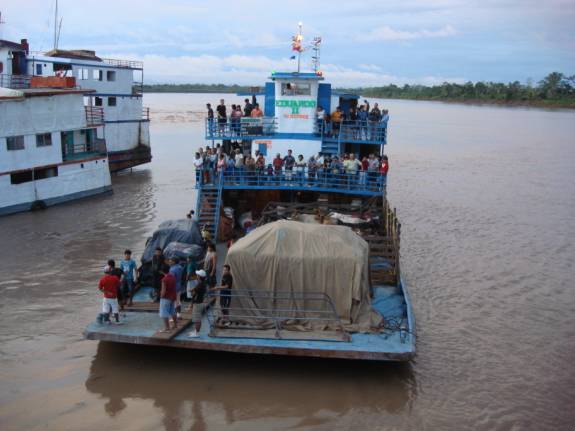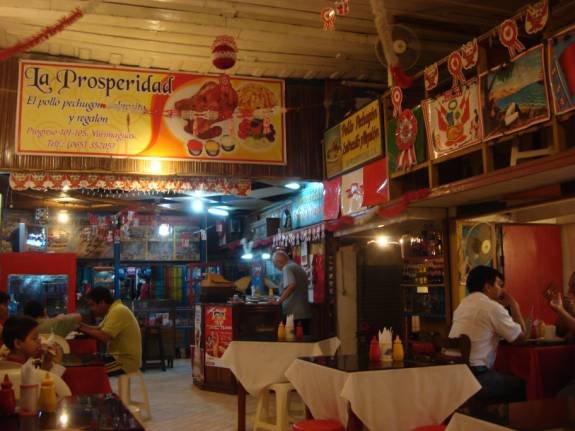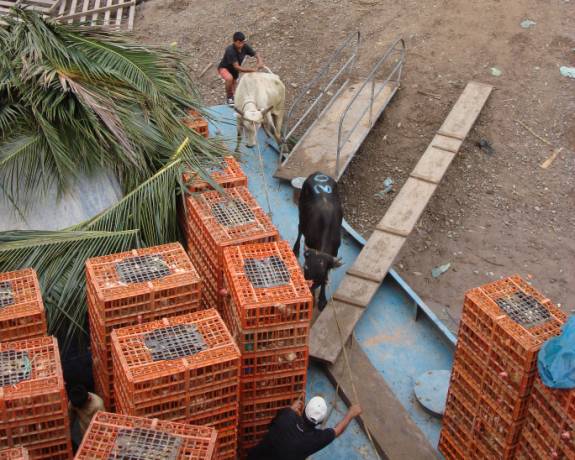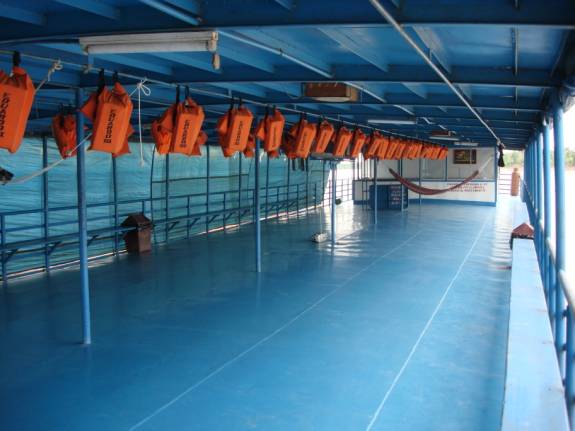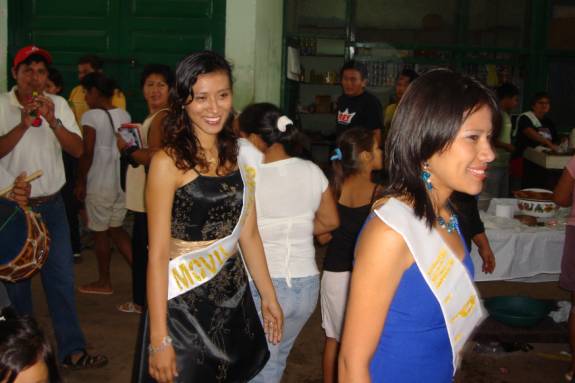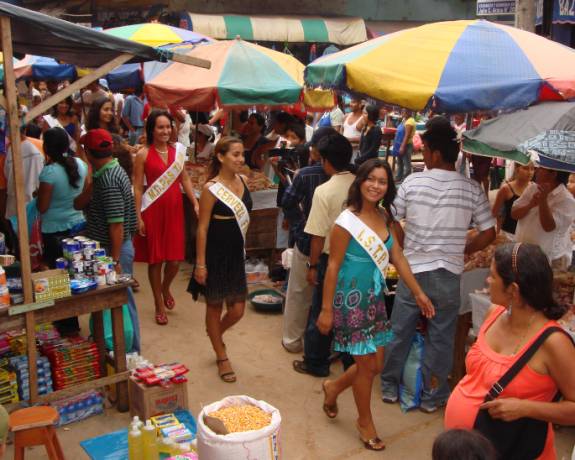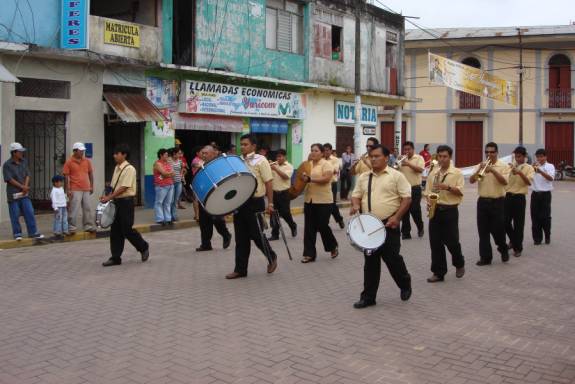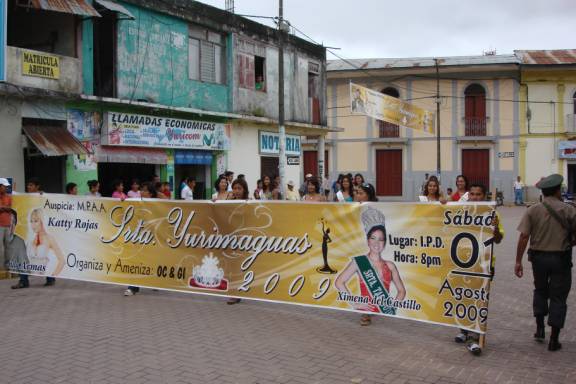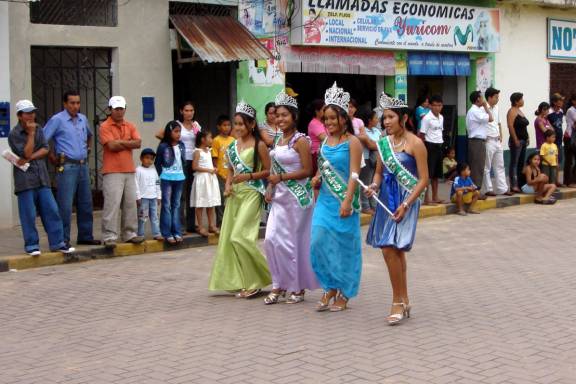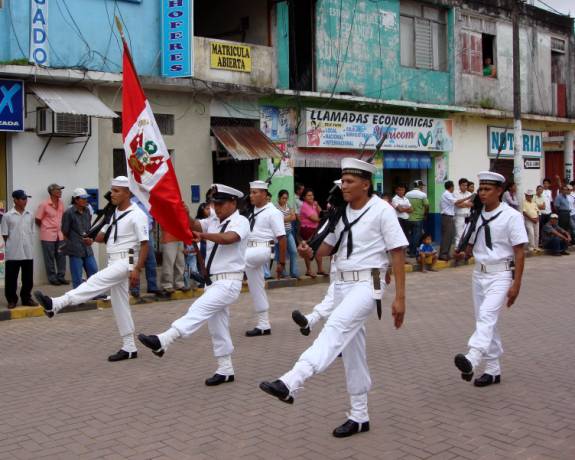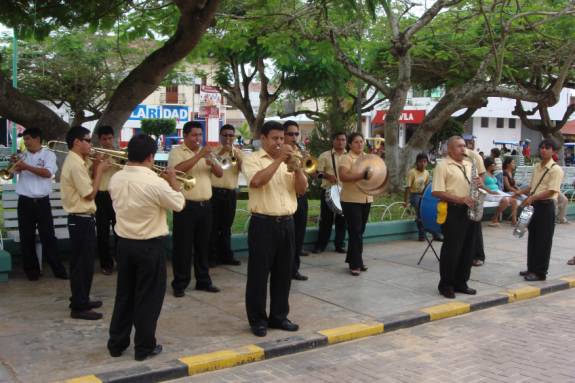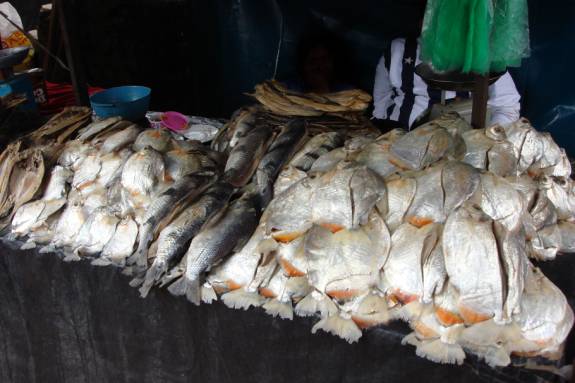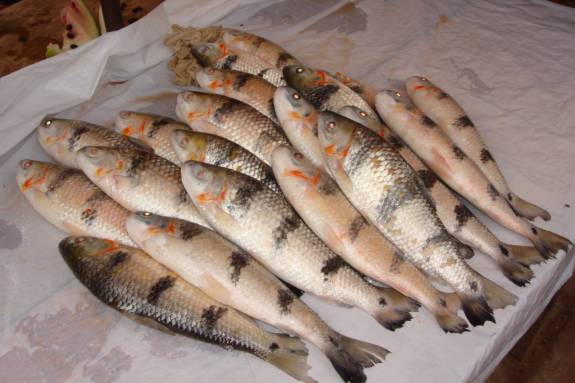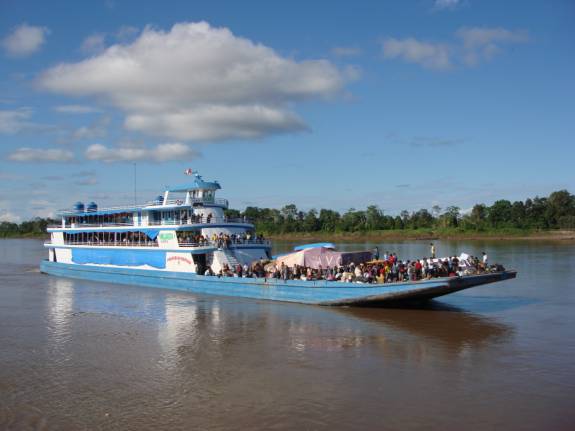|
|
|
|
Site Index:
|
UPDATE#25 07/23 thru 07/26
Howdy Everybody, The adventures of 2006, 2007,
2008, and 2009 through 07/22/09 have been published on the website.
We continue with the latest edition, which is the 6th in the
Peru Series. UPDATE 2009 #25
07/23/09 thru 07/26/09 At last update, we were in
Chachapoyas, enjoying our adventure trip in the north central highlands of Peru. 07/23/09
THURSDAY CHACHAPOYAS, PERU
Our experiences in the Chachapoyas area have been very exciting and
adventurous thus far. Although the alarm was set for 6:45am, I was awake early.
Even at 6am, all was quiet and the doors at Hostal Rumi Huasi were still
locked-up tight.
After breakfast at the
Panadería San Jose, we strolled by the central Plaza to the Chachas
Tours office where Rolando had previously arranged for our visit to
Kuelap.
By the Plaza, our group van was waiting across and in front of
Rolando’s office.
Judy and I had the front seats next to the driver for the two and a half
hour trip to the site. From our
viewpoint, the scenery was spectacular.
Mostly along dirt and gravely roads, we could view rural life in Peru up
close.
The site of Kuelap is perched high on a mountaintop.
We wisely elected to ride horses to the top of the rutty, muddy trail.
These were not rider-trained horses and they had to be led by young girls
who were adept at their task.
The view was wonderful as we climbed higher and higher to 9,843 feet
above sea level. Some of the younger travelers chose to hike the challenging
trail. The cost to ride up was less
than $2 each. Being led, we had
much more time to enjoy the scenic vistas without worrying about twisting an
ankle or slipping on rock and mud.
The girls dropped us off and headed back down the mountain in hopes of
rounding up some more riders. They
promised to return for us after we visited the site.
The fortress of Kuelap is enormous.
Kuelap is the most grandiose
citadel discovered thus far and is said to be the largest building structure in
all the Americas. Historians report that the Chillaos people constructed
this massive complex.
Forming a part of the Chachapoyas Culture, they rose to a prominent
position of power in this area of northern Peru.
Kuelap was constructed with 5 levels of stonewalls built inside of more
walls. Outer protection was provided by a series of huge walls with some well
over 60 feet high.
A simplified plan view of the fortress layout was provided for reference.
Note the three entrances and circular construction of the inner
buildings.
Access to the huge fortress was only available through three narrow slits
in the solid outer wall. This
feature would force any potential attackers into single-file forces and that
would be on foot.
The discovery of Kuelap did not occur until 1843.
It is believed that the fortress had remained unknown to both the Incas
and the Spanish Conquistadores.
Amazingly, it has been calculated that they utilized three times more
materials than were used at Egypt’s largest pyramid in Giza.
We gained access through the secondary entrance opening.
Several black llamas roamed freely about the grounds.
The second set of defensive walls would be equally difficult for
attackers to penetrate.
Imagine trying to direct any large contingent of armed attackers through
and up the narrow passageways. The
defenders had a distinct advantage over any offensive force.
The tower building at the summit…
Our guide to the site spoke only Spanish.
Having read about Kuelap, and its history, helped to enhance my
understanding of the place and the people.
Estimates are that many millions of cubic feet of cut stone and materials
were used at the site.
Although we didn’t personally count them, it has been said
that there were over 400 stone buildings erected within the inner top 3 levels.
Examples of decorative, rhomboidal frieze designs abound.
Currently, only about 40% of the fortress has been excavated.
Periods of mist and rain got us a bit wet but failed to dampen our
fascinated spirit of adventure. Note
the stepped platform design and the zigzag frieze patterns typical of the
Chachapoyas Culture.
The construction of Kuelap is believed to have taken
some 200 years to complete. This
single reconstruction illustrates the magnificence that must have existed during
Kuelap’s primetime.
The excellent strategic position provided an extensive observation point
from which to control the defenses and the trade routes throughout the valleys.
The exploration of the main passageway, only recently excavated by
archaeologists in 2005 and 2006, uncovered a tomb and various period designs
carved into the stone blocks, including animals, snakes, and heads.
With the weather clearing, we headed out of the site grounds.
As promised, the girls were there with our horse transportation.
Our choice to ride proved to be a good one.
One of our fellow travelers fell on the slippery trail and came limping
down, covered with mud and broken glasses in hand.
I wonder, how do you say, “Yee-Haw” and “Giddy-Up” in Spanish?
As seen from across the valley, the arrow points to the immense edifice
of Kuelap and its strategic location.
Along the remote dirt roads on our return, we could see the traditional
ways that have been practiced for centuries.
Heavy bags of produce, most likely potatoes, are carried from the fields
to locations like this along the main roadway for transfer to trucks.
The group of travelers stopped at the El Gran Shubet Restaurant for a
late lunch.
More spectacular scenic views were revealed at every turn of the road.
It was 6pm when we arrived back in the small city of Chachapoyas.
A lighter dinner choice was made at
Caldos Mary, located near the Plaza de Armas.
The soup, Caldo de
Gallina, was meaty and good. Helping
us relax, we had coffee and dessert at the
Panadería San Jose.
Planning to leave very early on our trip tomorrow, we arranged for the
doors of the Hostal Rumi Huasi to be unlocked at 4:15am.
It was sleepy time at 9:30pm. 07/24/09
FRIDAY CHACHAPOYAS to
YURIMAGUAS, PERU
Our packs were closed up last night before bed.
With a 4am alarm set, we made our way out onto the dark streets at
exactly 4:15am. A few blocks away,
we found the area for the collective taxis.
Within a few minutes, we had three more people headed the same way.
These collective taxis leave when full, so, piling in, we were on our way
for the hour-long trip to the junction at Pedro Ruiz.
The total fare for both of us was only about $7.
Hoping to catch a passing bus, we were quickly approached to take a
collective van onward. With eight people in the van, Judy got stuck on the middle
jump seat. The fare was about $10 each. About
45 minutes after our 5:35am departure, we came to a very sharp curve on the
narrow paved road. Attempting to
pass a big truck on a corner, the truck swung wide and our driver was squeezed
into a fender bender collision. The sounds of tires and crunching metal soon followed.
With seemingly little damage, the two vehicles just continued like
nothing had happened. I guess we were real lucky in the unfortunate clash since the
curve bordered on a very steep cliff. Oh
well, chalk it up to another adventure situation…
We stopped for breakfast in the town of
Moyabamba. I got to survey
the right front fender damage and it appeared relatively minor.
I would imagined that the owner of the nearly new van would be quite
angry and that the driver’s job might be in jeopardy. Several people disembarked here and we continued onward with
only three passengers. Despite his
attempts, the driver could not drum up any more riders.
The destination of this van was
Tarapoto. The van driver
dropped us along the main road into town. Once
again, being not exactly sure where we were, we asked and relied on the local
knowledge of a MotoTaxi driver to help us out.
He told us that, nearby, we could catch a regular bus later on today, or
he could take us across town to another location for a collective taxi that
would be much faster. Somewhat
reluctantly, we said, “Vamonos”,
or “Let’s Go”.
At a busy, muddy market section, he dropped us at the origination point
for the collective taxis.
We paid the fare of about $8.50 each and waited patiently for about 15
minutes while they gathered up a couple more passengers.
The driver stopped at a pretty nice place for lunch.
Judy and I shared a meal of soup and fresh fish for less than $3 total.
At 3pm, we had already been traveling for over 10 hours when we reached
the town of Yurimaguas. Again, we were unsure of exactly where to go, but several
MotoTaxi drivers with local knowledge were vying for our business.
We chose one to take us to the riverbanks where the cargo boats stage.
The driver was very helpful in getting us connected with the boat people.
There is no office and the boat
personnel conduct all business. We
had several boats to choose from but our driver suggested we try the Eduardo
III. We were the first ones to
arrive at the boat so we had our choice of accommodations.
Although the chalkboard sign said “Mañana”,
or tomorrow, we learned that it would be several days before they would leave.
Even though the other boats might be leaving sooner, this proved to be
our best option.
We had our choice of a lower deck hammock, an upper deck hammock, a bunk
bed room without bath, or a double room with private bath.
They agreed that we could stay aboard from now through our trip.
We opted to pay the extra for the “best” room. Although the price was a bit steeper, we were in no big rush
so it became a value by staying the extra nights.
We also felt more comfortable with the ability to secure our bags in a
locked compartment. On this boat,
there were only four of the bunk style rooms and only two rooms having a double
bed and bath. We were fortunate to
get one of them. I must explain
that when I say, “best room”, I’m certainly not talking about luxury.
This is a cargo vessel that takes passengers too.
The room was simply welded steel walls, a bed, a humble shower and toilet
with no seat. There were numerous “Araña”
or “spider” webs around, which should have been expected since we are
in the river jungle of the Amazon.
A tow and barge were re-supplying at the private dock of the prominent
beer company.
The vast majority of the cargo
boats have no permanent dock facilities. The
merely shove their bows into the riverbanks from where they are loaded and
unloaded.
Since river travel is the only
mode of transportation in these areas, the numbers, sizes, and varieties of
different types of cargo boats is very interesting.
Passengers traveling relatively
short distances pack into covered vessels similar to this one.
MotoTaxi fares to the nearby
town center cost about 50 cents. We
went to town and had a Chinese style dinner at a local Chifa. Fearing the spiders that might be in our room, I bought some
spray cans of insecticide. We were
both exhausted and went back to the boat early.
With only the crew on board, we had the entire boat to ourselves.
Glad that we had the insecticide, I went on a killing spree with the
lethal blasts. We had
rented a couple of hammocks for daytime use on deck.
Being a bit congested, I took a Benadryl capsule and soon fell sound
asleep in that hammock. Judy had to awake me from a deep slumber to go back to the
room for the night. Somewhat
confident that I had eradicated the pesky arachnids, we could rest relatively
well. 07/25/09
SATURDAY YURIMAGUAS in
AMAZONAS, PERU
Very early in the morning,
loading activities were being conducted. We
had slept well and, having liberally sprayed our room, we had no problems from
spiders or insects.
Watching the loading process
was totally fascinating. Everything
is loaded by hand using strong, young manpower.
Carrying phenomenally heavy sacks, they streamed aboard in steady lines.
There were no forklifts, no conveyer belts, no
cranes, no wheeled carts; only strong legs and backs toted the weighty
loads in the same manner used for centuries.
There were no hardhats, no safety shoes, no safety
glasses, no back braces, and no OSHA posters or placards.
The wheelhouse of the vessel
was incredibly simplistic. There
were no controls other than a wheel and throttle.
There was no equipment for radio navigation, no GPS, no VHF
communications, no engine instrumentation, no windshield wipers, and not even a
compass was there. As it has been
for centuries, riverboat guidance still relies on the captain and crew to have
experienced knowledge.
The cargo loads consisted of
everything imaginable. From
livestock to lumber, from fresh produce to sacks of salt, from sugar to
furniture, the porters lugged or prodded everything aboard.
Perhaps the most interesting
and comical was the loading of hogs. The
loudly squealing pigs vehemently resisted, seeming to know their destiny.
The handlers employed every conceivable method to forcefully urge the
swine to comply.
From big trucks, loose loaded
oranges were packed into heavy sacks to be carried down the muddy bank.
With all the heavy rains, the
tributary river into the
Huallaga was swollen and nearly raging with swift current. A banana raft broke loose from its tether and was swiftly
escaping downstream. Valiant
attempts by these workers to harness the runaway were futile to capture it.
I was easy to see that they were no match for the powerful forces of
nature. After careening off one of
the cargo boats, it floated off down the main river.
Being their main source of livelihood, we hope they were later successful
in retrieving the raft. There was a
lot of yelling and screaming going on during the pandemonium.
The porters’ ability to carry
extreme loads was amazing. The
second man here is carrying two sacks at 50 kilograms each.
At 2.2 pounds per kilo, that load weighs 220 pounds.
Just imagine, he is going to do this backbreaking labor all day long.
Most of the early activity was
loading the EDUARDO II. Our vessel,
the EDUARDO III, would have to wait patiently for its turn. You can see Judy watching intently from the upper deck of our
vessel.
The main mode of land
transportation is comes from literally thousands of MotoTaxis.
We hailed one to take us from the riverbank to the town center.
The street markets are the focal point of activity.
Available for sale, these fresh
fish from the rivers create an attractive display.
The cathedral and municipal
buildings are the focal points around the central Plaza de Armas.
The plaza itself is attractive and neatly kept.
This government building was
receiving a fresh coat of colorful paint.
All kinds of goods, vegetables,
grains, eggs, dairy products, and chickens were on display to tempt the
passersby.
Under threatening skies, we
returned to the EDUARDO III. Within
minutes, a torrential downpour turned the riverbank into a muddy, slippery goop.
Cargo loaders scurried to protect their products with plastic tarps.
Here in the Amazon jungle, they must get plenty of experience with
conditions like this.
The crew lowered the rain
shielding tarps to keep out the pelting rain.
On the still empty upper deck, we relaxed peacefully in the “hamacas
colgante” (hanging hammocks).
As the rains subsided, the
ALBERTITO eased away from the riverbank into the muddy Huallaga River.
Aboard our sister vessel, an
armed squad of soldiers conducted an inspection of the passengers and cargo.
In this jungle environment, I wonder what they could have been looking
for… Yah, right!
Lighter rain showers continued
throughout the afternoon. All that
soft, pure rainwater offered the perfect opportunity to lather up my curly
locks. Aaahh, yes, it was so
refreshing…
This deckhand started to paint
ID numbers on these cattle from inside the pen.
He soon realized the error of his ways when the bovine became restless.
He quickly chose a safer alternative position from which to continue his
bright red artwork.
At the dock of the beer
company, a brilliant rainbow fell gracefully on the fully loaded barge.
In this case, the proverbial “pot of gold” turned out to be the
bottles of “golden Cerveza”
(Beer, my friends, luscious golden beer).
Now, the EDUARDO II was in the
final stages of loading and the passengers were anxious to get underway.
Our attention turned to the
loading area as another load of bulls arrived by truck.
As the handlers carefully tried to control them, the crowd of onlookers
would scatter and run as the bulls turned ornery.
The EDUARDO II pushed back
between the other boats and began the down river slug toward
Iquitos.
With the weather calmed down,
we went into town. Our dinner at
the La Prosperidad
Restaurant was very good. The place
was very clean, nicely decorated, and they served tasty meals. What more could we ask for?
Judy said it was the best chicken dinner yet.
Back at the boat, we treated
any remaining spiders their evening insecticide dessert. I think we’ve been quite effective in keeping the pesky,
eight-legged pestilence in check. Being
quite allergic to their venom, I react badly to most insect bites.
Frankly, they all scare the living hell out of me.
Perhaps the jungle life is not the best suited for me?
Enjoying relaxing music from
our iPods, we swayed gently in our upper deck hammocks until quite late before
retiring to our room. 07/26/09
SUNDAY YURIMAGUAS in
AMAZONAS, PERU
By 6am, the loading of the boat was already in full force.
A steady stream of porters moved in ant-like columns packing unbelievable
loads upon their backs. Sunrise
across the Rio Huallaga painted the sky with tranquil beauty.
Another of the loaded boats churned out a mild wake heading for
Iquitos.
An additional herd of bulls and cattle was being loaded aboard EDUARDO
III. Cautiously hiding behind the
orange crates, the handler coaxed the huge chunk of living beef with a guiding
rope. The other handler used the
technique of vigorously twisting its tail as it came on deck.
With one guy fearing being gored and the other fearing being forcefully
kicked, they managed to successfully maneuver the bovine animals into their
staked corrals. Then, it was back
for a couple more and the sequence repeated.
Note the orange boxes of egg layers that have been meticulously attended
to since their loading. The hens
were fed, watered, and their eggs were gathered regularly. Alternately arranging
the palm fronds served to maintain the ideal temperatures in the coups.
With a taut rope wrapped tightly around the horns, a sharp twist of the
tail yielded somewhat compliant results.
The upper deck of the EDUARDO III remains empty.
This level might be considered as the “first class” section of
hammock accommodations. The more
crowded level below might be the equivalent of “economy class”.
At almost double the fare, travelers on the upper level have access to
community shower rooms and will have meals served in the small dining area seen
aft. Passengers from below are
prohibited from coming upstairs to this level at all times.
On the lower level, passengers must bring their own bowl to the serving
line where food is dispensed from ladles in slop style.
We went back into town for some last minute supplies and sightseeing.
We were delighted to be in time for the bevy of beauties vying for the
coveted title of, “Señorita
Yurimaguas – 2009”. Contestants
cheerfully flaunted their charm through the indoor and outdoor market sections,
offering their most gracious smiles to all.
If I were eligible to vote, can you guess to whom mine might be cast?
Ou Ou, Babalu, I think I’m in love (or lust).
Sorry Jimmy Carter, you ain’t alone…
The city and provincial leaders, officials, and dignitaries lined up for
the parade presentation.
A high-stepping honor guard from the National Police Forces proudly
displayed the Peruvian flag.
… as did this group from the “Armada Naval de Peru” (Navy).
A unique series of parade floats, propelled by the ubiquitous MotoTaxis,
were decoratively arranged in an unusual and artistic way…
The municipal band sounded out their melodic salute…
After the conclusion of the parade event, we returned to the market
section. I continue to be
fascinated by the diverse variety and array of fresh river “pescado”
(fish). You probably won’t find this assortment at your hometown
fishmongers.
Back at the boat, we watched the arriving GILMER I nestle onto the
riverbank next to us. Passengers
anxious to disembark crowded the foredeck.
In the relaxing afternoon warmth, Judy peacefully napped in her hammock.
With a deck of cards, I played numerous hands of Solitaire.
Soon, it was dinnertime at the Chifa in town.
The “Tallarines
con Verduras Y Champiñones”
(noodles with vegetables and mushrooms) made a delightful choice to share.
The EDUARDO III is scheduled to make its departure tomorrow morning.
Vamonos! (Let’s Go!)… CONTINUING
UPDATES IN THE PERU SERIES ARE IN PROGRESS… PLEASE WATCH FOR THEM, COMING SOON… POST SCRIPT:
We sincerely hope that you will review the previous years of compilations
to give context to the current editions. Please
let us know if you have any special suggestions and thoughts.
REMEMBER: The website
is now fully active and you can visit it at any time.
You can also review any of the previous logs from the years 2006, 2007,
or 2008 and learn more about the crew and their many adventures.
Enjoy. ATTENTION:
SPECIAL NOTE:
You may contact us via email anytime. Thanks
for allowing us to share our life and adventures with you. Lotsa
Luv, Fred
Reed and Judy Law AMARSE MT40 "AMARSE"
is pronounced "AM-ARE-SAY".
Our website is: www.amarse.net .
|
|
Fred H. Reed |
www.amarse.net © 2006 2007 2008 2009 2010 2011 |

